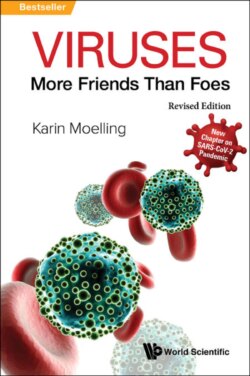Читать книгу Viruses: More Friends Than Foes (Revised Edition) - Karin Moelling - Страница 19
На сайте Литреса книга снята с продажи.
Influenza 1918
ОглавлениеThe beginning of the Influenza outbreak in 1918 has been reconstructed. A farmer in the USA, who had pigs and ducks became infected by an influenza virus. It is known that Influenza viruses can exchange genetic fragments with other influenza viruses, a process designated by virologists as reassortment. This must have created the most dangerous virus ever. The farmer was recruited to the military, became a cook there, and was sent to Europe. He may have been the index case, the case number one, of the Spanish flu. The name “Spanish” is incorrect; although viruses were long named according to the country of their first identification, this one did not arise in Spain but more probably in America. Nowadays such nomenclature is no longer used. In Europe, World War One was ongoing, with living conditions that favored the spread of the virus. This virus cost 50 to 100 million people their lives. Several approaches were taken to explain why especially so many young men died. Researchers succeeded in isolating some biological material from a woman who died during the Spanish flu of influenza and was buried in permafrost in Alaska. The sample was excavated in the 1990s and allowed researchers to isolate viral genetic material, which was sequenced at the Centers for Disease Control and Prevention (CDC) in Atlanta, USA. The high death rate among younger people was attributed to viral sequences to explain the unusual cytokine storms, overreactions of the immune systems of the infected young soldiers (Taubenberger et al. Science 310, 27, 2005). It may be worth comparing this effect with the severity and the cause of death of SARS-COVID-19 patients, which may — similarly — be caused by an overreacting immune response and cytokine storm. Since then, researchers have always considered the possibility of another Influenza epidemic like this one. Others have given more weight to the possibility of another SARS-corona epidemic. Bill Gates has repeatedly warned of both of these viruses, influenza and coronaviruses in particular, in short movies, and he has supported research into them.
Recently, the course of the 1918 influenza pandemic was reconstructed for many US cities and published in National Geographic (March 2020). The highest death rate occurred in Philadelphia, where no measures against the outbreak were taken, which led to a high bell-shaped curve and no successive further outbreaks. In all other twenty cities where counter-measures against the viral spread had been taken, the course of the virus infection exhibited two peaks, like the two humps of a camel. They varied in size and distance from each other, whereby the exit strategy was of high importance, the timepoint to terminate restrictions against the virus after the first outbreak. The profile of the virus replication worldwide showed a second peak, much higher and broader than the first one and also a weaker third peak occurred. This course of the viral infection from 1918 with the second high peak is the fear for 2020. What type of exit strategies should be taken today to avoid such a surge? With high-speed computers available today, model-builders are actively proposing various scenarios, all of which are based on initial assumptions — and are therefore uncertain. Models were proposed at Imperial College London, and different second or third waves have been envisaged; even the possibility of many returning small waves has been discussed.
One important parameter in such predictions is the reproduction number R0 which defines the number of people infected by a person, if two are infected R0 equals 2. R0 may have been 7 early during the pandemic, even up to 59 in special cases, the goal is R0 < 1, as then the pandemic comes to a halt. With an R0 = 3, 66.6% of the population needs to be infected and must have acquired antibodies and resistance to a second infection.
The influenza pandemic of 1918 also stimulated research to learn how animal viruses find their way from animals into humans. Two researchers tried to identify the respective mutations in the influenza strain from bird flu (H5N1), which set off a strong competition between Yoshihiro Kawaoka, from Japan and the USA, and Ron Fouchier of Erasmus Center in Rotterdam, Holland. They tried to identify the mutations that allow Influenza to grow on human cells. This is a similar “gain of function”, GOF, experiment as was performed with coronaviruses mentioned above. They tried to publish this supervirus with potential for a pandemic. However, their papers were compulsorily withheld for 60 days for evaluation by a committee of 22 scientists at the WHO. The papers, it was suggested, could have taught lessons to bioterrorists and there is even a word for it, “dual-use”, meaning information for science and terrorism!
Surprisingly, the WHO — like the authors — stressed that the information was more valuable than the potential risk was dangerous, and that one can learn from it for future preventive measures. However, this type of research should be supervised in the future. The papers were published in a reduced version (Nature 486, 420, 2012 and Science 336, 1534, 2012). Three of the dangerous mutants identified are apparently already present in some natural isolates of Influenza and should be watched out for, because only one additional mutation may lead to a new pandemic. Can we learn from this for future risks?
